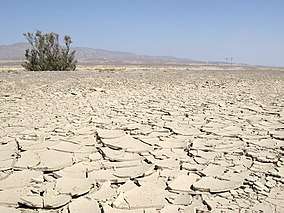Repetek Biosphere State Reserve
Repetek Biosphere State Reserve, often referred to as Repetek Nature or Desert Reserve, (Turkmen: Repetek goraghanasy, Репетек горагханасы) is a desert nature reserve (zapovednik) of Turkmenistan, located in Lebap Province, East Karakum Desert, near Amu Darya. It is located approximately 70 km (43 mi) south from Türkmenabat and is known for its zemzen (desert monitor which is Varanus griseus). Established in 1928 for the study and preservation of a sand-desert ecosystem, it covers an area of 346 km2 (134 sq mi).
| Repetek Biosphere State Reserve | |
|---|---|
 | |
 Map of Turkmenistan | |
| Location | Lebap Province, Turkmenistan |
| Nearest city | Türkmenabat |
| Coordinates | 38°36′22″N 63°12′50″E[1] |
| Area | 346 km2 (134 sq mi) |
| Established | 1928 |
Geography
The landscape of the reserve is arid, with extensive ridged sand dunes some 15–20 m (49–66 ft) in height and 8–10 m (26–33 ft) in length in many areas, large areas of sand dune and valley-like depressions.[2] Black saxaul (Haloxylon aphyllum), rare to most part of Central Asia covers more than 1,470 km2 (570 sq mi), approximately 4.5% of the territory of the reserve. The soils have sandy subsoils, but some "21 trees, 104 grasses, 8 mushrooms, 1 moss, 68 soil algae and 197 fungi" grow within the reserve.[2]
History
The Repetek sandy desert scientific station was organized in 1912 by the decision of the Russian Geographical Society, and the reserve was established in 1928 on the base of the scientific station.[3] During the Soviet period the reserve belongs to the Institute of Deserts of the Turkmen SSR Academy of Sciences. The list of scientific publications concerning with the Repetek sandy desert station and the biosphere reserve since 1982 to 1991 consists of about 250 papers (30% on landscape structure and geography, 20% on botany and 50% on zoology).[4]
The Institute of Deserts, Flora and Fauna of the Academy of Sciences of Turkmenistan was established in 1962 to study ways of reclaiming desert land for economic use in the reserve.[5]
Environmental protection
The Repetek Biosphere State Reserve is part of an Important Bird Area (IBA) and since 1979 has been an under the monitoring of UNESCO but "the site is under the administration of the Ministry of Nature Protection of Turkmenistan".[2] The reserve "supports the most complete assemblage of bird species typical of the sand desert of the Karakum" and "has an important population of Goitered Gazelle (Gazella subgutturosa) which is listed as Vulnerable (VU) in the IUCN Red List".[2]
Climate
Repetek Biosphere State Reserve has a desert climate (Köppen climate classification BWk), with cool winters and very hot summers. Rainfall is generally light and erratic, and occurs mainly in the winter and autumn months.
| Climate data for Repetek Biosphere State Reserve | |||||||||||||
|---|---|---|---|---|---|---|---|---|---|---|---|---|---|
| Month | Jan | Feb | Mar | Apr | May | Jun | Jul | Aug | Sep | Oct | Nov | Dec | Year |
| Record high °C (°F) | 31 (88) |
35 (95) |
39 (102) |
42 (108) |
43 (109) |
48 (118) |
50 (122) |
49 (121) |
47 (116) |
42 (107) |
41 (106) |
31 (88) |
50 (122) |
| Average high °C (°F) | 7.3 (45.1) |
10.5 (50.9) |
17.4 (63.3) |
25.6 (78.1) |
32.3 (90.1) |
37.8 (100.0) |
39.8 (103.6) |
37.5 (99.5) |
32.1 (89.8) |
23.8 (74.8) |
16.6 (61.9) |
9.8 (49.6) |
24.2 (75.6) |
| Daily mean °C (°F) | 1.5 (34.7) |
4.1 (39.4) |
10.3 (50.5) |
18.1 (64.6) |
24.3 (75.7) |
29.5 (85.1) |
31.8 (89.2) |
29.0 (84.2) |
22.4 (72.3) |
14.6 (58.3) |
8.6 (47.5) |
3.7 (38.7) |
16.5 (61.7) |
| Average low °C (°F) | −3.0 (26.6) |
−1.1 (30.0) |
4.3 (39.7) |
10.9 (51.6) |
14.9 (58.8) |
18.3 (64.9) |
21.3 (70.3) |
18.2 (64.8) |
11.4 (52.5) |
5.7 (42.3) |
1.9 (35.4) |
−1.0 (30.2) |
8.5 (47.3) |
| Average precipitation mm (inches) | 19 (0.7) |
14 (0.6) |
27 (1.1) |
20 (0.8) |
9 (0.4) |
1 (0.0) |
0.2 (0.01) |
0.2 (0.01) |
0.4 (0.02) |
5 (0.2) |
10 (0.4) |
17 (0.7) |
122.8 (4.94) |
| Average precipitation days (≥ 1.0 mm) | 7 | 6 | 6 | 6 | 4 | 1 | 0 | 0 | 0 | 2 | 4 | 6 | 42 |
| Average relative humidity (%) | 69 | 63 | 54 | 47 | 33 | 24 | 23 | 24 | 31 | 43 | 57 | 69 | 45 |
| Mean monthly sunshine hours | 136.9 | 151.7 | 197.7 | 235.8 | 321.6 | 376.8 | 390.2 | 372.1 | 319.1 | 267.3 | 195.2 | 131.8 | 3,096.2 |
| Source: NOAA (1961-1990)[6] | |||||||||||||
Notes
- "Repetek Zapovednik Unesco Mab Biosphere Reserve". protectedplanet.net.
- UNESCO.
- Sokolov, Veiisov & Gunin 1990, p. 182
- Kuzmenko, Veiisov 1992, p. 76.
- Encyclopædia Britannica
- "Climate Normals for Repetek". National Oceanic and Atmospheric Administration. Retrieved 10 February 2013.
References
- National Program for the Protection of the Environment, Ashgabat, 2002, pp. 149–151 (in Russian)
- Kuzmenko VD, Veiisov SV (1992). "List of scientific publications on the Repetek sandy desert station and biosphere reserve, 1982-1991". Probl. osvoenya pustyn. Ylym (6): 76–85. (in Russian)
- Sokolov, VE; Veiisov, SV & Gunin, PD (1990). "The Repetek Reserve". In Sokolov, Vladimir & Syroechkovsky, Eugeny (eds.). Reserves of Central Asia and Kazakhstan (in Russian). Mysl. pp. 183–197. ISBN 5244002732.CS1 maint: ref=harv (link)
External links
- "Repetek Biosphere State Reserve". UNESCO. Archived from the original on February 26, 2013. Retrieved February 26, 2013.
- Image Flickr